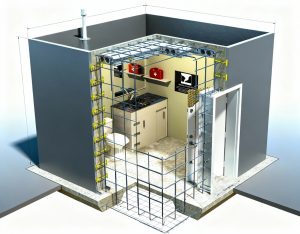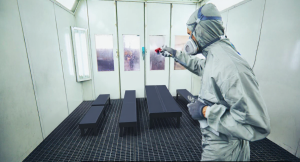Polyurea is no longer a newcomer for flat roof waterproofing applications, yet many stakeholders still associate it more with truck beds and secondary containment than with the sun‑washed expanse of a low‑slope roof. The problem is that misperception leaves value on the table. Polyurea’s rapid cure, chemical resilience, and freedom from seams align almost perfectly with the real‑world pressures that drive premature roof failures, namely thermal cycling, unpredictable weather windows, and the rising cost of callbacks. Here we’ll step through the core processing decisions that turn a drum of hot, reactive resin into a decades‑long weather shield.
CHEMISTRY DESIGNED TO PROTECT A MOVING TARGET
Flat roofs never stay still, regardless of what they are made of. Concrete breathes, metal does too, and even “dead‑level” decks ripple when large HVAC units cycle on. That’s why polyurea’s value starts with its molecular backbone, which is composed of amine and isocyanate components that react internally rather than evaporating carrier solvents. The resulting elastomer is both quick and forgiving: it gels fast enough to shed an approaching cloudburst yet stays flexible long after asphaltic membranes have stiffened. That flexibility is what fortifies seams, corners, and parapet transitions against the slow tear of differential movement. So polyurea is an adaptive skin rather than simply a thick liquid coating, letting project teams frame every subsequent decision, such as primer choice, spray rate, and topcoat selection, around a single goal: maintaining continuity across the roof’s inevitable flex.
READING THE ROOF BEFORE SEALING IT OFF
Moisture trapped in a concrete deck or buried in insulation is the silent saboteur of many coating jobs, regardless of chemistry. Polyurea is more tolerant than solvent‑borne technologies, but tolerance is not the same as immunity. The prudent approach is therefore two‑fold: verify substrate dryness with a reliable moisture test and provide for vapor escape through breathable primer systems or vented base plates where needed. On recovery projects, a core cut that exposes decades‑old tar or brittle felts can reveal stress risers hiding in plain sight. Address them first; a seamless polyurea topcoat will be able to replicate whatever lies beneath.
THE PROCESSING VARIABLES THAT MATTER THE MOST
Every installer knows the headline numbers, think temperature, pressure, and spray distance, but the story between those values often decides whether a roof earns a twenty‑year warranty or becomes a year‑three headache. Balanced pressures keep the “A” and “B” sides stoichiometric, but so does hose routing that avoids cold parapet shadows. Heat management, likewise, is more choreography than thermostat: raising drum temperature means little if the last twenty feet of hose snake through an icy wind. Rather than chase a single “ideal” setting, seasoned crews treat the rig as a live system, recording readings at the pump, midway, and gun to build a thermal map of the day. That map becomes a predictive tool, serving to anticipate when the roof edge will drop below the resin’s comfort zone and scheduling spray passes accordingly.
FULL-SURFACE DURABILITY
Real waterproofing earns its keep at drains, pitch pans, terminations, and the junction where a parapet meets a change in deck elevation. Polyurea’s speed allows applicators to embed reinforcing mesh seamlessly into wet film, turning what might have been a three‑component metal flashing into a single, chemically fused joint. The key is intentional sequencing: pre‑strip corners and penetrations, embed fabric while the film is still receptive, then return with full‑field passes that knit fresh material onto a partially reacted but chemically active surface. Done correctly, the eye cannot find a cold joint, and water cannot find a leak path.
WRAPPING UP WATERTIGHT
The flat‑roof arena is crowded with options, each loudly and proudly advertising its own strong suit, like reflectivity, puncture resistance, or installation cost. Polyurea does not win on any single superlative; it wins by combining its advantages to eliminate the weakest link in the waterproofing chain: the seam. So when the owner, specifier, and installer approach the project as a choreography of chemistry and craft, understanding movement, moisture, and mixing in equal measure, roofs behave like a single, resilient sheet even though it was sprayed layer by layer.






